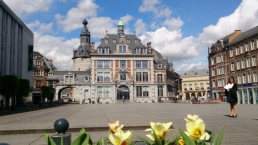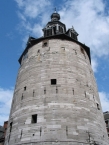Namur
Worth visiting
Added on 04 Apr 2015,
last edited by biroto-Redaktion on 10 Apr 2022
Nearby cycle routes and tours
| Route name | Type | Dist. to route |
|---|---|---|
Route | 0,4 km | |
Route | 0,4 km | |
Route | 0,4 km | |
Route | 0,4 km | |
Route | 0,4 km | |
Route | 0,4 km | |
Route | 0,4 km | |
Route | 0,8 km | |
Tour | 0,1 km | |
Tour | 0,1 km | |
Tour | 0,1 km | |
Tour | 0,2 km | |
Tour | 0,8 km |
![]()
Please wait - map data are loading
Type of sights
Heritage building(s)
Name and address
Namur
BE-5000 Namur
GEO-data
Geodetic coordinates
50.46∎∎∎∎ 4.86∎∎∎∎
Elevation
87 m
Communication
Information about copyright | |
|---|---|
Rights owner | |
Rights characteristic / license | by-sa: CREATIVE COMMONS Attribution-ShareAlike |
Link to the description of the license | |
Image taken over from | |
Image has been uploaded | by biroto-Redaktion on 04 Apr 2015
|
Information about copyright | |
|---|---|
Rights owner | |
Rights characteristic / license | by-sa: CREATIVE COMMONS Attribution-ShareAlike |
Link to the description of the license | |
Image taken over from | |
Image has been uploaded | by biroto-Redaktion on 04 Apr 2015
|
Information about copyright | |
|---|---|
Rights owner | |
Rights characteristic / license | by-sa: CREATIVE COMMONS Attribution-ShareAlike |
Link to the description of the license | |
Image taken over from | |
Image has been uploaded | by biroto-Redaktion on 04 Apr 2015
|
Information about copyright | |
|---|---|
Rights owner | |
Rights characteristic / license | by-sa: CREATIVE COMMONS Attribution-ShareAlike |
Link to the description of the license | |
Image taken over from | |
Image has been uploaded | by biroto-Redaktion on 04 Apr 2015
|
Namur (French pronunciation: [namyʁ], Dutch: Namen, Nameur in Walloon) is a city and municipality in Wallonia, in southern Belgium. It is both the capital of the province of Namur and (since 1986) of Wallonia. It hosts the Walloon Parliament.
Namur stands at the confluence of the Sambre and Meuse
rivers and straddles three different regions - Hesbaye to the north, Condroz to the south-east and Entre-Sambre-et-Meuse to the south-west. The language spoken is French.
Understand
The town began as an important trading settlement in Celtic times, straddling east-west and north-south trade routes across the Ardennes. The Romans established a presence after Julius Caesar defeated the local Aduatuci tribe.
Namur came to prominence during the early Middle Ages when the Merovingians built a castle or citadel on the rocky spur overlooking the town at the confluence of the two rivers. In the 10th century, it became a county in its own right. The town developed somewhat unevenly, as the counts of Namur could only build on the north bank of the Meuse - the south bank was owned by the bishops of Liège and developed more slowly into the town of Jambes (now effectively a suburb of Namur). In 1262, Namur fell into the hands of the Count of Flanders, and was purchased by Duke Philip the Good of Burgundy in 1421.
After Namur became part of the Spanish Netherlands in the 1640s, its citadel was considerably strengthened. Louis XIV of France invaded in 1692, capturing the town and annexing it to France. His renowned military engineer Vauban rebuilt the citadel. French control was short-lived, as William III of Orange-Nassau captured Namur only three years later in 1695 during the War of the Grand Alliance. Under the Barrier Treaty of 1709, the Dutch gained the right to garrison Namur, although the subsequent Treaty of Utrecht of 1713 gave control of the formerly Spanish Netherlands to the Austrian House of Habsburg. Thus, although the Austrians ruled the town, the citadel was controlled by the Dutch. It was rebuilt again under their tenure.
France invaded the region again in 1794, during the French Revolutionary Wars, and again annexed Namur, imposing a repressive regime. After the defeat of Napoleon in 1815, the Congress of Vienna incorporated what is now Belgium into the United Kingdom of the Netherlands. Belgium broke away from the Netherlands in 1830 following the Belgian Revolution, and Namur continued to be a major garrison town under the new government. The citadel was rebuilt yet again in 1887.
Namur was a major target of the German invasion of Belgium in 1914, which sought to use the Meuse valley as a route into France. On August 21st, 1914, the Germans bombarded the town of Namur, without any previous notice given. Several persons were killed. Despite being billed as virtually impregnable, the citadel fell after only three days' fighting and the town was occupied by the Germans for the rest of the war. Namur fared little better in World War II; it was in the front lines of both the Battle of the Ardennes in 1940 and the Battle of the Bulge in 1944. The town suffered heavy damage in both wars.
Namur continued to host the Belgian Army's paratroopers until their departure in 1977.
See
- ⊙ The town's most prominent sight is the citadel, now demilitarised and open to the public.
- ⊙ 18th century Cathédrale Saint-Aubain
- ⊙ The Saint Loup church, located in the historical heart of the city, is one of the most beautiful pieces of baroque art inherited from the former southern Netherlands, mid-July to mid-September: We: 2:00 pm - 6:00 pm Sa: 11:00 am - 6:00 pm (guided tour on 3 PM) Su: 2:00 pm - 6:00 pm, September to June) Sa: 11:00am - 4:00pm (guided tour on 3:00 PM).
- ⊙Belfry
classified by UNESCO as part of the Belfries of Belgium and France which are listed as a World Heritage Site.
- ⊙Musée provincial des arts anciens, Rue de Fer, 24, ☎ +32 81 220065.daily, from 10:00 to 18:00. Closed on Mondays. Adults 3 €, students and senior citizens 1,50€, Children under 12 free. Medieval and Renaissance collections of the Namur Archaeological Society and the extraordinary medieval treasury of the Saint-Nicolas d’Oignies priory.
- ⊙Musée diocésain et trésor de la cathédrale Saint-Aubain (Diocesan Museum houses the prestigious treasury of Saint- Aubain), Place du Chapitre, 1 (The museum can be accessed via the cathedral), ☎ +32 81 444285, ☎ +32 476 972324. Reserve your visit by telephone at M. Jacques Jeanmart, Rue de l'Eglise, 5150 Franière phone numbers see above. Adults2,50 €, students and senior citizens 2 €, groups1,50 €, children 1 €. Gold and silver pieces (XI to XVIII century), sculptures and paintings from parishes and ancient abbeys of the diocese of Namur. Mediaeval glasses, textiles and manuscripts.
An odd Namurois custom is the annual Combat de l'Échasse d'Or (Fight for the Golden Stilt), held on the third Sunday in September. Two teams, the Mélans and the Avresses, dress in medieval clothes while standing on stilts and do battle in one of the town's principal squares.
Sleep
Inside the range of 4 km:
- ⊙ Grand Hôtel de Flandre, Namur, PC VI - IX
"... We have a secure room for bicycles and motorcycles. It is a locked room. It is a completely free service."
- ⊙ Hotel ibis Namur Centre, Namur, PC VI - VII
"... that we have a bicycle shelter in the closed car park of the hotel. Otherwise we can also close your bikes in a closed room."
- ⊙ Hôtel Les Tanneurs, Namur, PC V - X
"... that we have a secure bike room which is located in a reserved corner of our barrier car park (same street as the hotel). Our cameras monitor the entire car park and, consequently, also access to the bike room throughout the day. Keys are only kept at Reception."
Useful
Inside the range of 4 km:
- ⊙ Office du Tourisme de Namur, Namur
Information about copyright
Rights characteristic / license
by-sa: CREATIVE COMMONS Attribution-ShareAlike
Link to the description of the license
Input taken over from:
- Wikipedia contributors, 'Namur, Belgium', Wikipedia, The Free Encyclopedia, 13 February 2015, 03:31 UTC, http://en.wikipedia.org/w/index.php?title=Namur,_Belgium&oldid=646897516
 [accessed 4 April 2015]
[accessed 4 April 2015] - Wikivoyage-Bearbeiter, 'Namur', Wikivoyage, Freie Reiseinformationen rund um die Welt, 13. August 2016, 11:24 UTC, https://de.wikivoyage.org/w/index.php?title=Namur&oldid=947841
 [abgerufen am 9. September 2016]
[abgerufen am 9. September 2016]
taken over / edited on
04 Apr 2015 - 09 Apr 2022
taken over / edited by
- ⊙ Hotel ibis Namur Centre, Namur, PC VI - VII
Nearby cycle routes and tours
| Route name | Type | Dist. to route |
|---|---|---|
Route | 0,4 km | |
Route | 0,4 km | |
Route | 0,4 km | |
Route | 0,4 km | |
Route | 0,4 km | |
Route | 0,4 km | |
Route | 0,4 km | |
Route | 0,8 km | |
Tour | 0,1 km | |
Tour | 0,1 km | |
Tour | 0,1 km | |
Tour | 0,2 km | |
Tour | 0,8 km |
Added on 04 Apr 2015,
last edited by biroto-Redaktion on 10 Apr 2022




